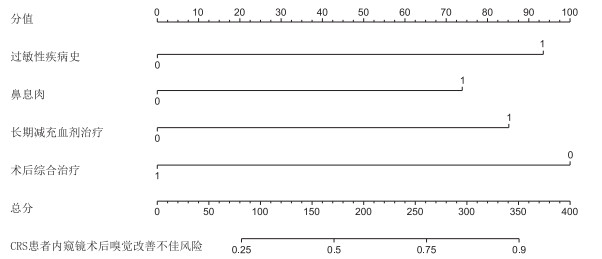Construction and analysis of predictive model of poor olfactory improvement in patients with chronic rhinosinusitis after endoscopic surgery
-
摘要:
目的 通过构建慢性鼻-鼻窦炎(chronic rhinosinusitis,CRS)患者鼻内窥镜治疗后嗅觉改善不佳的预测模型,为临床工作提供指导。 方法 回顾性分析2018年3月—2021年3月于杭州师范大学附属医院耳鼻咽喉科行鼻内镜手术治疗的125例CRS患者的临床资料,所有患者均伴有嗅觉障碍,根据术后嗅觉障碍改善情况分为满意组和不满意组,通过单因素分析筛选影响嗅觉改善的因素并进行logistic多因素分析,根据logistic回归方程构建预测模型,并分析其预测效能。 结果 本研究最终纳入125例患者临床资料进行分析,其中满意组84例,不满意组41例。Logistic多因素分析提示既往过敏性疾病史(B=1.145,OR=3.141,95% CI:1.282~7.693)、鼻息肉(B=0.905,OR=2.472,95% CI:1.025~5.962)和长期减充血剂(B=1.043,OR=2.837,95% CI:1.164~6.917)是嗅觉恢复的危险因素,术后坚持综合治疗(B= -1.225,OR=0.294,95% CI:0.107~0.807)是嗅觉恢复的保护性因素。列线图模型预测CRS患者鼻内窥镜治疗后嗅觉改善不佳的C-index为0.745(0.739~0.819),校正曲线显示列线图模型预测可能性绝对误差为0.043。 结论 过敏性疾病史、鼻息肉、长期减充血剂、术后坚持综合治疗是嗅觉恢复的影响因子,根据上述指标建立的列线图模型可用于CRS患者鼻内窥镜治疗后嗅觉改善情况的预测。 Abstract:Objective To provide guidance for clinical work by constructing a predictive model of poor olfactory improvement in patients with chronic rhinosinusitis (CRS) after nasal endoscopic treatment. Methods The clinical data of 125 patients with CRS who underwent endoscopic sinus surgery in the Department of Otorhinolaryngology, Affiliated Hospital of Hangzhou Normal University from March 2018 to March 2021 were retrospectively analysed. All patients were accompanied by olfactory disorders. The improvement of olfactory disorders was divided into satisfactory group and unsatisfactory group. Factors affecting olfactory improvement were screened through single-factor analysis, and logistics multi-factor analysis was carried out. A prediction model was constructed according to the logistics regression equation, and its prediction performance was analysed. Results The clinical data of 125 patients, including 84 cases in the satisfactory group and 41 cases in the unsatisfactory group, were analysed. Logistics multivariate analysis revealed that a history of allergic diseases (B=1.145, OR=3.141, 95% CI: 1.282-7.693), nasal polyps (B=0.905, OR=2.472, 95% CI: 1.025-5.962) and long-term reduction congestion (B=1.043, OR=2.837, 95% CI: 1.164-6.917) is a risk factor for olfactory recovery. Adherence to comprehensive treatment (B= -1.225, OR=0.294, 95% CI: 0.107-0.807) is a risk factor for olfactory recovery. The nomogram model predicted that the C-index of CRS patients with poor olfactory improvement after nasal endoscopic treatment was 0.745(0.739-0.819). The calibration curve showed that the absolute error of the prediction probability of the nomogram model was 0.043. Conclusion A history of allergic diseases, nasal polyps, long-term decongestants and post-operative adherence to comprehensive treatment are the factors affecting olfactory recovery. The nomogram model established based on the above indicators can be used for olfactory improvement after nasal endoscopic treatment in patients with CRS patients. -
Key words:
- Chronic rhinosinusitis /
- Endoscopic sinus surgery /
- Olfactory dysfunction /
- Prediction model /
- Nomogram
-
表 1 2组CRS患者临床资料比较
组别 例数 性别(男/女, 例) 年龄[M(P25, P75), 岁] 吸烟[例(%)] 饮酒[例(%)] 鼻息肉[例(%)] 病程[例(%)] 过敏性疾病[例(%)] ≤3年 >3年 满意组 84 45/39 44(41, 50) 36(42.86) 29(34.52) 26(30.95) 26(30.95) 58(69.05) 24(28.57) 不满意组 41 19/22 46(38, 50) 15(36.59) 17(41.46) 23(56.10) 14(34.15) 27(65.85) 20(48.78) 统计量 0.576a 0.882b 0.449a 0.571a 7.309a 0.129a 4.933a P值 0.448 0.379 0.503 0.450 0.007 0.719 0.026 组别 例数 长期减充血剂治疗[例(%)] 术后综合治疗[例(%)] 嗜酸性粒细胞百分比(x±s, %) 中性粒细胞百分比(x±s, %) 淋巴细胞百分比(x±s, %) JESREC评分[M(P25, P75), 分] Lund-Mackay评分[M(P25, P75), 分] 满意组 84 21(25.00) 70(83.33) 6.96±2.49 57.92±11.11 29.28±8.43 14(12, 16) 15(12, 18) 不满意组 41 17(41.46) 26(63.41) 7.23±3.14 57.79±13.35 28.73±10.94 14(13, 16) 15(10, 18) 统计量 3.529a 6.135a 0.482c 0.054c 0.283c 0.329b 0.915b P值 0.060 0.013 0.632 0.957 0.778 0.742 0.360 注:a为χ2值,b为Z值,c为t值。 表 2 变量赋值表
变量 赋值方法 嗅觉恢复情况 满意=1,不满意=0 过敏性疾病 是=1,否=0 鼻息肉 是=1,否=0 长期减充血剂 是=1,否=0 术后综合治疗 是=1,否=0 表 3 2组CRS患者嗅觉改善的logistic多因素分析
变量 B SE Wald χ2 P值 OR值 95% CI 过敏性疾病 1.145 0.442 6.271 0.012 3.141 1.282~7.693 鼻息肉 0.905 0.450 4.060 0.044 2.472 1.025~5.962 长期减充血剂 1.043 0.593 5.259 0.022 2.837 1.164~6.917 术后综合治疗 -1.225 0.461 5.645 0.018 0.294 0.107~0.807 -
[1] 孟繁杰, 毕静, 盛迎涛, 等. 内窥镜鼻窦术中对中鼻甲不同处理的手术效果比较[J]. 中华全科医学, 2019, 17(2): 222-224, 229. https://www.cnki.com.cn/Article/CJFDTOTAL-SYQY201902017.htm [2] 沙敏, 李勇, 李静. HGF与TGF-β1的平衡在慢性鼻窦炎组织重塑中的作用[J]. 中华全科医学, 2017, 15(4): 663-666. https://www.cnki.com.cn/Article/CJFDTOTAL-SYQY201704038.htm [3] 汤国栋, 周军, 郑伟昌. 慢性鼻窦炎患者鼻黏膜组织GATA结合蛋白-3表达及与炎性因子水平的关系[J]. 中华实用诊断与治疗杂志, 2019, 33(1): 50-52. https://www.cnki.com.cn/Article/CJFDTOTAL-HNZD201901016.htm [4] 李冰慧. 鼻窦内窥镜手术联合糖皮质激素治疗慢性鼻-鼻窦炎患者疗效分析[J]. 蛇志, 2018, 30(3): 465-466, 502. doi: 10.3969/j.issn.1001-5639.2018.03.030 [5] 张华艳. 鼻内窥镜手术治疗慢性鼻窦炎77例临床效果分析[J]. 现代医药卫生, 2016, 32(6): 890-892. doi: 10.3969/j.issn.1009-5519.2016.06.032 [6] TSUZUKI K, HASHIMOTO K, OKAZAKI K, et al. Post-operative course prediction during endoscopic sinus surgery in patients with chronic rhinosinusitis[J]. J Laryngol Otol, 2018, 132(5): 408-417. doi: 10.1017/S0022215118000543 [7] 任军, 皇甫辉. 慢性鼻-鼻窦炎伴嗅觉障碍患者鼻内镜手术前后嗅觉变化分析[J]. 临床耳鼻咽喉头颈外科杂志, 2016, 30(2): 106-110. https://www.cnki.com.cn/Article/CJFDTOTAL-LCEH201602005.htm [8] 张星, 王震, 雷莉. 慢性鼻-鼻窦炎患者嗅觉障碍患病情况及其影响因素[J]. 华南预防医学, 2020, 46(1): 14-17. https://www.cnki.com.cn/Article/CJFDTOTAL-GDWF202001006.htm [9] 张丽川, 孙敬武, 胡春华, 等. 慢性鼻窦炎伴鼻息肉患者嗅觉障碍的影响因素分析[J]. 中华耳鼻咽喉头颈外科杂志, 2020, 55(4): 350-357. https://www.cnki.com.cn/Article/CJFDTOTAL-EBYT202110002.htm [10] 郑铭, 王敏, 李颖, 等. 慢性鼻窦炎伴鼻息肉的免疫炎性标志物表达及其对术后复发的预测价值[J]. 中华耳鼻咽喉头颈外科杂志, 2019, 54(3): 174-180. [11] 左可军, 储宇宵, 张植诚, 等. 中国慢性鼻-鼻窦炎诊断和治疗指南全国应用调查[J]. 中华耳鼻咽喉头颈外科杂志, 2015, 50(1): 50-53. doi: 10.3760/cma.j.issn.1673-0860.2015.01.011 [12] 中华耳鼻咽喉头颈外科杂志编辑委员会鼻科组, 中华医学会耳鼻咽喉头颈外科学分会鼻科学组. 慢性鼻-鼻窦炎诊断和治疗指南(2012年, 昆明)[J]. 中华耳鼻咽喉头颈外科杂志, 2013, 48(2): 92-94. doi: 10.3760/cma.j.issn.1673-0860.2013.02.002 [13] CIKRIKCI S, ERKAN E, AGDAS F. Association between septoplasty, Lund-Mackay score and Lund-Kennedy score with endoscopic dacryocystorhinostomy results[J]. Orbit, 2021, 40(4): 274-280. doi: 10.1080/01676830.2020.1782441 [14] NAKAYAMA T, SUGIMOTO N, OKADA N, et al. JESREC score and mucosal eosinophilia can predict endotypes of chronic rhinosinusitis with nasal polyps[J]. Auris Nasus Larynx, 2019, 46(3): 374-383. doi: 10.1016/j.anl.2018.09.004 [15] SALAZAR I, SANCHEZ-QUINTEIRO P, BARRIOS A W, et al. Anatomy of the olfactory mucosa[J]. Handb Clin Neurol, 2019, 164: 47-65. [16] HAN X, WU D, SUN Z, et al. Type 1/type 2 inflammatory cytokines correlate with olfactory function in patients with chronic rhinosinusitis[J]. Am J Otolaryngol, 2020, 41(5): 102587. doi: 10.1016/j.amjoto.2020.102587 [17] HAUSER L J, CHANDRA R K, LI P, et al. Role of tissue eosinophils in chronic rhinosinusitis-associated olfactory loss[J]. Int Forum Allergy Rhinol, 2017, 7(10): 957-962. doi: 10.1002/alr.21994 [18] 訾晓雪, 赵莉, 金鹏, 等. 伴有嗅觉障碍的慢性鼻-鼻窦炎患者鼻内镜术后嗅觉及生活质量转归的研究[J]. 山东大学耳鼻喉眼学报, 2016, 30(1): 21-25. https://www.cnki.com.cn/Article/CJFDTOTAL-SDYU201601006.htm [19] 张丽川, 孙敬武, 李希平, 等. 内镜鼻窦手术对慢性鼻-鼻窦炎伴鼻息肉患者嗅觉功能转归的影响[J]. 临床耳鼻咽喉头颈外科杂志, 2019, 33(8): 713-717. https://www.cnki.com.cn/Article/CJFDTOTAL-LCEH201908008.htm [20] GLEZER I, MALNIC B. Olfactory receptor function[J]. Handb Clin Neurol, 2019, 164: 67-78. [21] GAO C, DU Q, LI W, et al. Baicalin modulates APPL2/glucocorticoid receptor signaling cascade, promotes neurogenesis, and attenuates emotional and olfactory dysfunctions in chronic corticosterone-induced depression[J]. Mol Neurobiol, 2018, 55(12): 9334-9348. doi: 10.1007/s12035-018-1042-8 [22] 杜伟强, 李志伟, 周明. 鼻内镜手术治疗慢性鼻-鼻窦炎患者嗅觉改善的相关因素分析[J]. 实用临床医药杂志, 2017, 21(7): 2. https://www.cnki.com.cn/Article/CJFDTOTAL-XYZL201707040.htm [23] BIGGS T C, HAYES S M, HARRIES P G, et al. Immunological profiling of key inflammatory drivers of nasal polyp formation and growth in chronic rhinosinusitis[J]. Rhinology, 2019, 57(5): 336-342. [24] 修倩, 高奕瑶, 朱冬冬. 低氧刺激鼻息肉黏膜上皮细胞炎性因子变化的初探[J]. 中华耳鼻咽喉头颈外科杂志, 2021, 56(3): 263-272. doi: 10.3760/cma.j.cn115330-20200814-00674 [25] 杨焕焕, 方红, 尤权杰, 等. 组织嗜酸粒细胞及鼻窦CT对慢性鼻-鼻窦炎伴鼻息肉术后复发的预测研究[J]. 中华耳鼻咽喉头颈外科杂志, 2018, 53(11): 842-846. doi: 10.3760/cma.j.issn.1673-0860.2018.11.009 [26] 李帅祥, 李霞, 陈晓红, 等. Notch通路在鼻息肉中的表达及其与调节性T细胞表达和嗜酸粒细胞浸润的相关性研究[J]. 中华耳鼻咽喉头颈外科杂志, 2021, 56(2): 124-132. doi: 10.3760/cma.j.cn115330-20200814-00675 [27] 廖敏, 李双, 刘江怡, 等. 嗜酸性粒细胞在鼻息肉复发中的作用研究进展[J]. 国际耳鼻咽喉头颈外科杂志, 2020, 44(2): 96-99. doi: 10.3760/cma.j.issn.1673-4106.2020.02.007 [28] 孟晓敏, 李华瑞, 刘峰. miR-125b在嗜酸性粒细胞性鼻窦炎中的表达模式及生物学作用[J]. 河北医科大学学报, 2019, 40(1): 105-108. doi: 10.3969/j.issn.1007-3205.2019.01.026 [29] SCHOSSER R J, SMITH T L, MACE J C, et al. Factors driving olfactory loss in patients with chronic rhinosinusitis: A case control study[J]. Int Forum Allergy Rhinol, 2020, 10(1): 7-14. doi: 10.1002/alr.22445 -





 下载:
下载:



